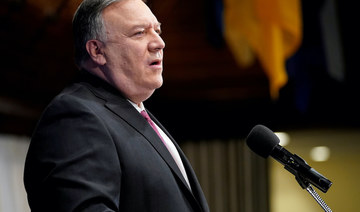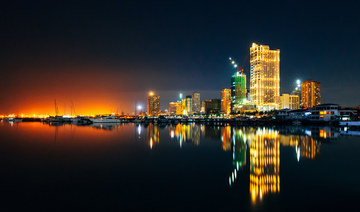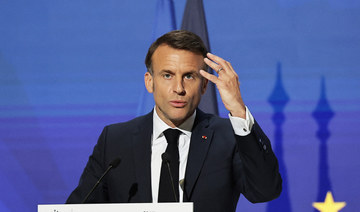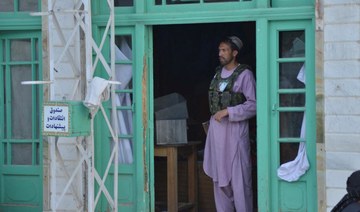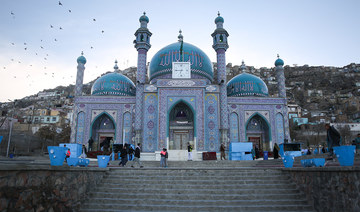GENEVA: The United Nations’ human rights chief on Friday cited the need for an “independent and comprehensive assessment” of the rights situation in China’s Xinjiang region, while emphasizing that activists, lawyers and rights defenders face unfair charges, detention and trials in China.
UN High Commissioner for Human Rights Michelle Bachelet said her office is working to find “mutually agreeable parameters” for her to visit China, including Xinjiang. Efforts to arrange such a visit for the human rights commissioner date to before she took office in September 2018.
Bachelet discussed China while giving the UN’s Human Rights Council her regular update on the rights situation worldwide, this time involving some 50 countries.
Bachelet credited China’s progress in curbing COVID-19 but said “fundamental rights and civic freedoms continue to be curtailed in the name of national security and the COVID-19 response.” She said over 600 people are being investigated for participating in protests in Hong Kong.
Concerns about detention centers — which China calls training centers — for Muslim Uyghurs and others in Xinjiang have provoked human rights concerns for many months, and Bachelet’s office and Chinese authorities have so far failed to arrange a visit for her to the region.
“In the Xinjiang Uyghur Autonomous Region, information that is in the public domain indicates the need for independent and comprehensive assessment of the human rights situation,” Bachelet said, adding that her office was looking into reports of arbitrary detention, ill-treatment and sexual violence in institutions, among other rights issues.
Rights office spokeswoman Ravina Shamdasani said discussions were continuing for a “preparatory technical mission” that could pave the way for Bachelet to visit China. Shamdasani said such a mission was needed before a Bachelet visit “to ensure meaningful access.”
Bachelet’s address ran through an array of rights concerns and issues, including “the growing expansion of the definition of ‘foreign agent’” in Russia; a “serious contraction of civic space” in several countries in southeast Asia; “excessive use of force” against demonstrators in some South American countries, and “charges of sedition against journalists and activists” in India for reporting or commenting on protests by farmers there.
She noted several European governments restricted the work of groups that defend migrants’ rights, and cited some 50 cases opened in Germany, Greece, Italy, Malta, the Netherlands and Spain over the last five years involving humanitarian search and rescue missions in the Mediterranean Sea.
The comments were separate from other Bachelet speeches and council discussions on “major country situations” about places that included Belarus, Myanmar, Sri Lanka, Venezuela
Overall, Bachelet cautioned about the impact of COVID-19 on human rights.
“Today, in every region of the world, people are being left behind — or pushed even further behind — as the coronavirus pandemic continues to gather pace,” she said.
UN rights chief cites ‘need’ to assess rights in Xinjiang
https://arab.news/m6p3h
UN rights chief cites ‘need’ to assess rights in Xinjiang
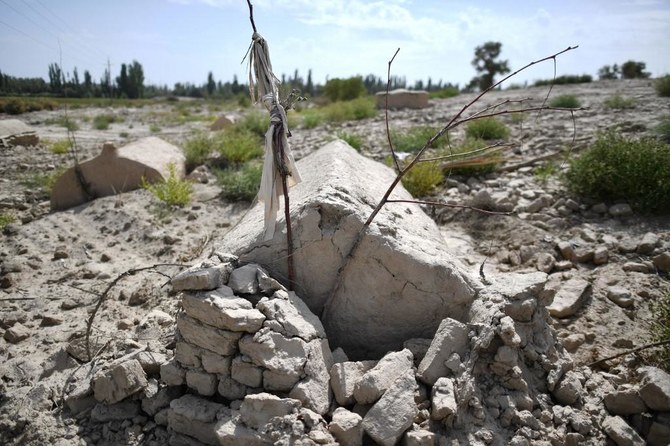
- Concerns about detention centers for Muslim Uyghurs in Xinjiang have provoked human rights concerns
- Bachelet’s office and Chinese authorities have so far failed to arrange a visit for her to the region
More war debris in Gaza than Ukraine: UN

“Gaza has more rubble than Ukraine, and to put that in perspective, the Ukrainian front line is nearly 1,000 kilometers long, and Gaza is 40 km long,” said UNMAS’s head Mungo Birch
GENEVA: The Gaza Strip is filled with more war debris and rubble than Ukraine, the head of UN demining operations for the narrow Palestinian territory said Wednesday.
And the danger for clearance work is restricted not just to unexploded ordnance but includes possible exposure to toxic substances such as asbestos.
The United Nations Mine Action Service (UNMAS) estimated the amount of debris in Gaza at 37 million tons in mid-April, or 300 kilogrammes per square meter.
“Gaza has more rubble than Ukraine, and to put that in perspective, the Ukrainian front line is 600 miles (nearly 1,000 kilometers) long, and Gaza is 25 miles (40 km) long,” said Mungo Birch, head of the UNMAS program in the Palestinian territories.
But the sheer volume of rubble is not the only problem, said UNMAS.
“This rubble is likely heavily contaminated with UXO (unexploded ordnance), but its clearance will be further complicated by other hazards in the rubble,” Birch told journalists.
“There’s estimated to be over 800,000 tons of asbestos, for instance, alone in the Gaza rubble.” The cancer-causing mineral used in construction requires special precautions when handling.
Birch said he hoped UNMAS, which works to mitigate the threats posed by all types of explosive ordnance, would become the coordination body for mine action in Gaza.
It has secured $5 million of funding but needs a further $40 million to continue its work in Gaza over the next 12 months.
However, “the sector as a whole will need hundreds of millions of US dollars over multiple years in order to make Gaza safe again for the population,” Birch added.
The Gaza war started after Hamas’s October 7 attack on southern Israel, which resulted in the deaths of 1,170 people, mostly civilians, according to an AFP tally of Israeli official figures.
Israel’s retaliatory offensive has killed at least 34,568 people in Gaza, mostly women and children, according to the health ministry in the Hamas-run territory.
Firefighters work on a building that was partially destroyed after a Russian bombardment in Chernihiv on Apr. 17, 2024. (AP/File)
Philippines bets on wellness, medical tourism to attract Middle Eastern visitors

- Philippines wants position as a leading halal tourism destination
- Nation aims to welcome 7.7m international visitors in 2024
MANILA: The Philippine tourism sector is shifting to promote the country as a medical and wellness destination, expanding beyond its recreational profile to attract more visitors from the Middle East.
More than 2 million international travelers visited the Philippines since the beginning of the year, with receipts between January and April reaching $2.7 billion. This data, the Department of Tourism said last week, was a 120 percent recovery rate from the same period in 2019 — before COVID-19 lockdowns brought the industry to a standstill.
The department’s data also showed a 10 percent increase in visitors arriving from Gulf countries, especially Saudi Arabia and the UAE, which are among the Philippine government’s key emerging-market targets.
To further boost their arrivals and make the country a more attractive destination, tourism stakeholders are shifting their strategy to focus more on the wellness sector, Philippine Tour Operators Association President Arjun Shroff told Arab News.
“This strategic shift aims to position the Philippines as an emerging medical and wellness destination in Asia, expanding beyond its traditional recreational tourism offerings like beaches and diving spots,” he said.
Efforts have also been undertaken to expand the footprint of halal services and goods.
The predominantly Catholic Philippines — where Muslims constitute about 10 percent of the nearly 120 million population — plans to raise 230 billion pesos ($4 billion) in investments and generate around 120,000 jobs by expanding its domestic halal industry by 2028.
The cross-sector efforts include tourism as well, with the Philippines trying to position itself as a leading halal tourism destination.
“We have recently implemented a range of strategic initiatives to enhance our appeal to visitors from the Middle East. Central to our approach is a commitment to inclusivity, ensuring that all tourists feel welcome and safe,” Shroff said.
“In line with this commitment, we have actively promoted halal establishments to cater to the dietary preferences of Middle Eastern travelers. By offering a variety of halal dining options, we aim to provide a seamless and enjoyable culinary experience.”
Filipinos have been exposed to the Middle East, especially Gulf countries, which are home to some 2 million Philippine expats. They understand cultural differences and many also know Arabic.
The tourism sector has lately been tapping into Arabic-speaking talent to help facilitate tours for Middle Eastern travelers.
“We have invested in bilingual tour guides proficient in Arabic ... These guides play a vital role in facilitating communication, providing valuable insights, and enhancing the overall experience for our Middle Eastern guests,” Shroff said.
“Philippine travel and tourism agencies strategically target the Middle East market ... (it) holds great potential for the Philippines.”
In 2024, the Philippines is targeting to welcome 7.7 million international visitors, nearly its pre-pandemic record-breaking achievement in 2019 which ended with 8.26 million inbound arrivals.
Resurgent terror groups in Afghanistan will strike West, warns resistance leader

- Exiled head of National Resistance Front says Al-Qaeda, Daesh presence growing in country
- Taliban emboldened by Western commitment to Ukraine, focus on Middle East
London: Terrorist groups in Afghanistan are regrouping in the wake of the Western evacuation from the country and will strike on US and European soil, the leader of an anti-Taliban movement has warned.
The exiled leader of Afghanistan’s National Resistance Front, Ahmad Massoud, said a terror attack in the US or Europe is “not about a matter of if, it’s a matter of when,” The Independent reported.
Massoud said circumstances in the country and the wider region resemble the pre-9/11 landscape, with terror training camps opening across Afghanistan.
Ali Maisam Naziry, the NRF’s head of foreign relations, said of the resurgent groups: “The attacks in Russia, Iran and Brussels, and the neutralised attack in Germany, are examples of how fast they are moving to threaten global security.”
He added that since the Taliban’s return to power in 2021, Afghanistan has witnessed a “massive influx” of foreign terrorist fighters who belong to the more than 20 militant networks operating in the country, including Al-Qaeda, Daesh-Khorasan and the Haqqani Network.
Massoud warned that the West’s commitment to Ukraine and Israel is serving as a distraction, emboldening the Taliban in the process.
Afghanistan is “no longer a priority” for the Biden administration in the US, he told The Independent last year.
Nathan Sales, a former US ambassador-at-large and coordinator for counterterrorism, said last year: “The continued partnership between the Taliban and Al-Qaeda is perhaps best seen in the fact that after the US withdrawal, Al-Qaeda leader Ayman Al-Zawahiri resurfaced in Afghanistan, living in a safe house associated with the Haqqani Network, a Taliban faction that maintains close ties to Al-Qaeda and is itself a US-designated Foreign Terrorist Organization.
“The key takeaway is that the Taliban felt emboldened to welcome Al-Qaeda’s leader back to Kabul, and Al-Qaeda’s leader felt it was safe enough there to accept the offer.”
Sudanese man detained in UK for deportation to Rwanda: NGO

- Asylum seeker attended routine sign-in at immigration center in London on Monday
- Home Office: First flight to African country ‘set to take off in 10-12 weeks’
LONDON: A Sudanese asylum seeker in the UK has been told of his imminent deportation to Rwanda after attending a routine Home Office appointment, The Guardian reported.
SOAS Detainee Support, an NGO, told the newspaper that the case is believed to be the first under the Rwanda scheme, which has received royal assent.
The UK government policy aims to deport rejected asylum seekers to the African country through a bilateral agreement.
The Sudanese man said he had arrived on Monday to sign in at the Lunar House immigration reporting center in Croydon, south London, but was told he would be deported to Rwanda, and was subsequently detained.
He is one of three people being held after attending the facility, including an Afghan national, SDS said.
The NGO, which offers advice and support to detained asylum seekers, said it had received an “alarmingly high number of calls” since the government’s announcement of Rwanda flights.
A Home Office spokesperson said in a statement: “Now that the Safety of Rwanda Act has passed and our treaty with Rwanda ratified, government is entering the final phase of operationalising this landmark policy to tackle illegal migration and stop the boats.
“This includes detaining people in preparation for the first flight, which is set to take off to Rwanda in 10-12 weeks.”
Daesh claims gun attack killing six in Afghan mosque
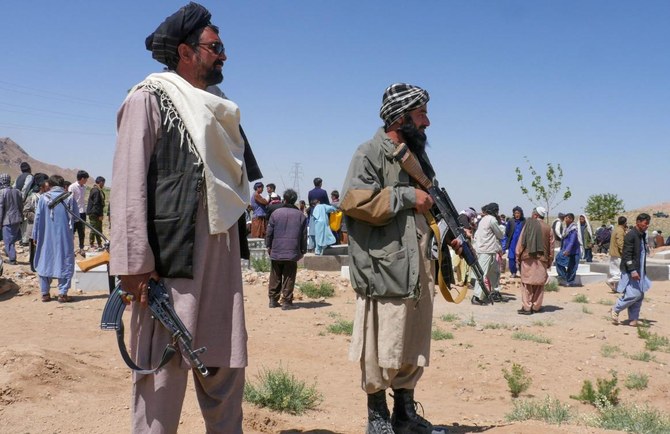
- Daesh said numerous gunmen had stormed the mosque with machine guns
HERAT: The Daesh group has claimed a gun attack on a minority Shiite mosque in western Afghanistan that killed six people on Monday.
Interior ministry spokesman Abdul Mateen Qani said Tuesday morning that “an unknown armed person shot at civilian worshippers in a mosque” in Herat province’s Guzara district at around 9:00 p.m. (1630 GMT) the previous night.
“Six civilians were martyred and one civilian was injured,” he wrote on social media platform X.
Late Tuesday, the regional chapter of Daesh group claimed responsibility and said numerous gunmen had stormed the mosque with machine guns — contradicting the official account of a single assailant.
Locals said the mosque, located just south of provincial capital Herat, served the minority Shiite community and that an imam and a three-year-old child were among those killed.
They said a team of three gunmen had staged the attack.
“One of them was outside and two of them came inside the mosque, shooting the worshippers,” said 60-year-old Ibrahim Akhlaqi, the brother of the slain imam. “It was in the middle of prayers.”
“Whoever was in the mosque has either been martyred or wounded,” added 23-year-old Sayed Murtaza Hussaini.
Taliban authorities have frequently given death tolls lower than other sources after bombings and gun attacks, or otherwise downplayed them, in an apparent attempt to minimize security threats.
Daesh in Afghanistan
The regional chapter of Daesh is the largest security threat in Afghanistan and has frequently targeted Shiite communities.
The Taliban government has pledged to protect religious and ethnic minorities since returning to power in August 2021, but rights monitors say they’ve done little to make good on that promise.
The most notorious attack linked to Daesh since the Taliban takeover was in 2022, when at least 53 people — including 46 girls and young women — were slain in the suicide bombing of an education center.
Taliban officials blamed Daesh for the attack, which happened in a Shiite neighborhood of the capital Kabul.
Afghanistan’s new rulers claim to have ousted IS from the country and are highly sensitive to suggestions the group has found safe haven there since the withdrawal of foreign forces.
A United Nations Security Council report released in January said there had been a decrease in Daesh attacks in Afghanistan because of “counter-terrorism efforts by the Taliban.”
But the report said Daesh still had “substantial” recruitment in the country and that the militant group had “the ability to project a threat into the region and beyond.”
The Daesh chapter spanning Afghanistan, Pakistan and Central Asia claimed responsibility for the March attack on the Crocus City Hall concert venue in Moscow, killing more than 140 people.
It was the deadliest attack in Russia in two decades.



